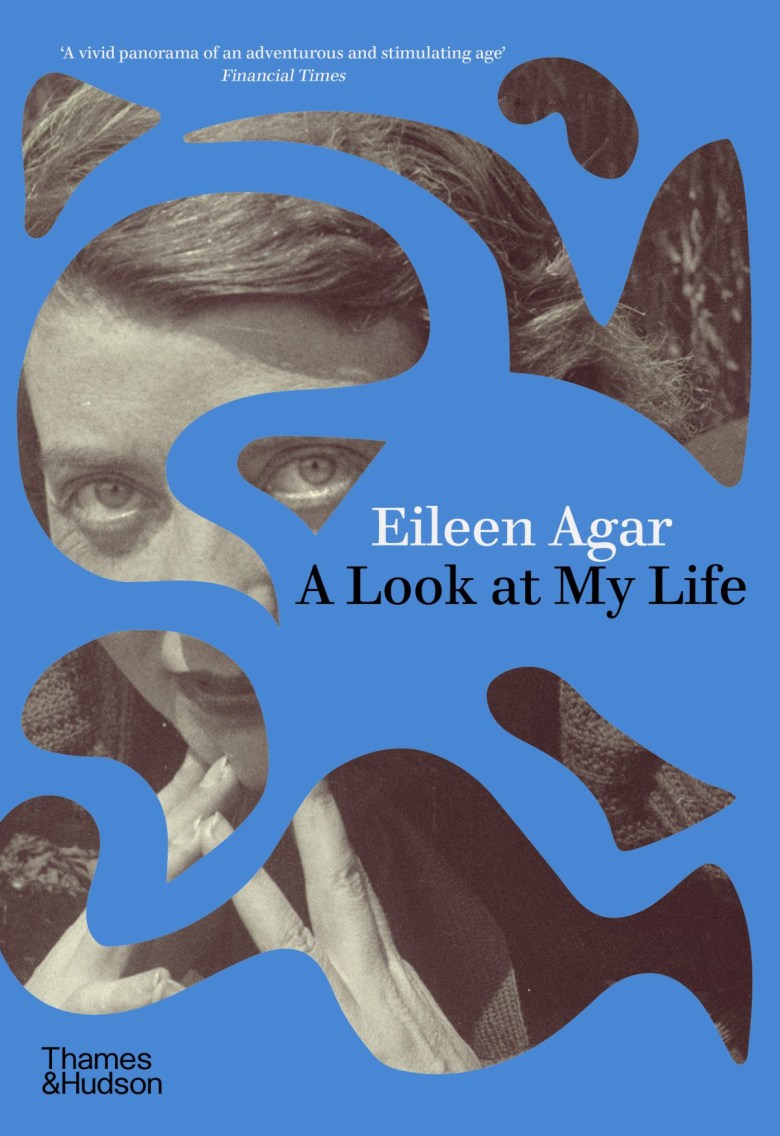Art history is a collaborative project, forever being written and revised. The legacies of artists are developed over time by a small army of contributors and shaped by forces beyond the art itself. Together they build an unwieldy collective portrait, one in which significant stories can sometimes fall by the wayside. It’s a treat, then, when old gems are recovered and refreshed, and land on your doorstep. One such gem arrived to me in the form of a vibrantly illustrated autobiography of the British-Argentinian Surrealist Eileen Agar, whose eyes peer out from the swirling, electric blue collage on the front cover.
The memoir was originally published in 1988, when the artist was 89 years old. After the death of her husband, the Hungarian writer Joseph Bard, Agar generated a mountain of written fragments describing their life together. The artist’s grand-niece remembers her as “a tiny bird-of-paradise engulfed in a giant red-and-white striped armchair surrounded by pyramids of colorful papers,” prolific until the very end. But Agar needed to weave these scraps of information into a narrative tapestry. She had initially wanted to focus on her husband’s life, yet as sweet as her memories of him may have been, her friends wisely steered her toward telling her own story. Andrew Lambirth then helped her write the book, seamlessly replicating her voice to tie the various threads together. “The true poem is not the work of the individual artist,” Agar writes, “it is the universe itself, in which the artist is a sort of somnambulist.” Published at a time when Surrealism was not in vogue, A Look at My Life fell out of print for decades, until a resurgence of institutional interest in her work — not to mention the centennial of Surrealism itself — led to Thames & Hudson’s newly reissued volume.

The book is a terrific beach read, though not for the usual reasons. Yes, Agar was a friend of Picasso and Ezra Pound, the lover of Paul Élouard and Paul Nash. She lived freely and traveled far from the Victorian social mores of her childhood. Her memoir sails from a wealthy childhood in Buenos Aires to high society balls in London’s Belgravia; from life as a newlywed in a thatched-roof cottage in Normandy to palling around with Pound in Portofino and vacationing with Picasso in Mougins. Agar’s prose is witty and easily devoured, reflecting the creativity of Surrealist automatic writing while avoiding that project’s at times self-indulgent excess. What makes this memoir ideal for seaside consumption, however, is the ever-present echo of the ocean in the artist’s life, and the starring role of aquatic forms in her work.
Some of the most important scenes of Agar’s story play out against a watery backdrop. In Argentina, it’s the “silken seashore of Mar del Plata … where the swirling foam made white calligraphic whisperings as it withdrew.” In Europe, she strolls along the Italian coast with famous poets and romps on the beach with the French Surrealists, participating in gatherings that anticipated the countercultural “happenings” of the 1960s. Later visits to Tenerife, in the Canary Islands, restored and replenished her artistic energy, which had been depleted by the devastation of World War II.
From André Breton’s L’Amour Fou to the films of Jean Painlevé, the Surrealists were obsessed with the amorphous boundaries between the human and marine worlds. Dora Maar merged woman and crustacean in her photography, while Yves Tanguy wandered the beach and used whatever surfaced as a starting point for his creative expressions. Marine motifs constantly recur in Agar’s oeuvre and life. “Surrealism for me draws its inspiration from nature,” she writes, “The sea and the land sometimes play together like man and wife, and achieve astonishing results.” When she first met Picasso on a beach in southern France, she collected bits of debris that had washed up on the shore and presented them to him “as a tribute.” This use of marine life as a kind of Duchampian readymade surfaces in one of her best-known (and perhaps funniest) artworks, “The Ceremonial Hat for Eating Bouillabaisse,” which the artist would don like a giant sand dollar on her head, encrusted with bits of shells, seaweed, lobster, and other oceanic detritus.
Everywhere she went, Agar seemed to develop a creative intimacy with the major figures of her generation — to the point that this almost becomes the book’s weakness. We move briskly through what she herself deems a “shopping list of people,” all equally impressive and occasionally difficult to keep track of. Figures like Rudyard Kipling, W.B. Yeats, and Sigmund Freud, as well as corporate kingpins and Lord and Lady something-or-other all stroll into the frame of one paragraph and are gone by the next. (Few memoirs end with such an index as this one!) This ceaseless montage of A-listers becomes its own assemblage, a colorful assortment of fish in Agar’s intellectual ocean. As she says: “My life is a collage, with time cutting and arranging the materials and laying them down, overlapping and contrasting.” For Agar, Surrealist automatism was catalyzed by the collective natural forces that she was immersed in: the ocean, time, the universe itself.
A Look at My Life by Eileen Agar in collaboration with Andrew Lambirth (2024) is published by Thames & Hudson and is available online and in bookstores.